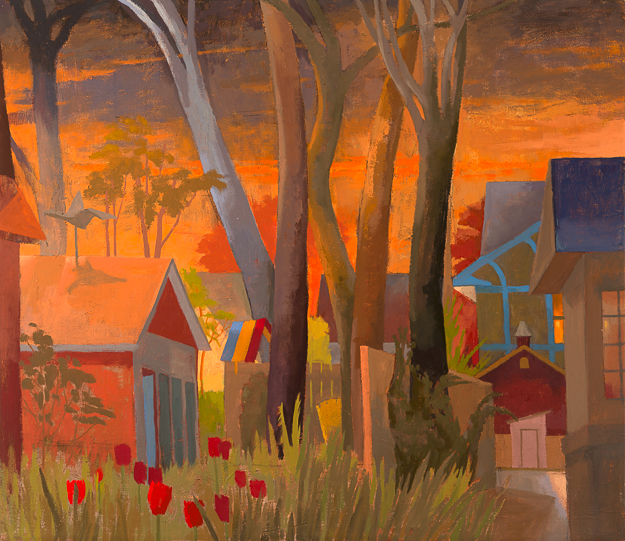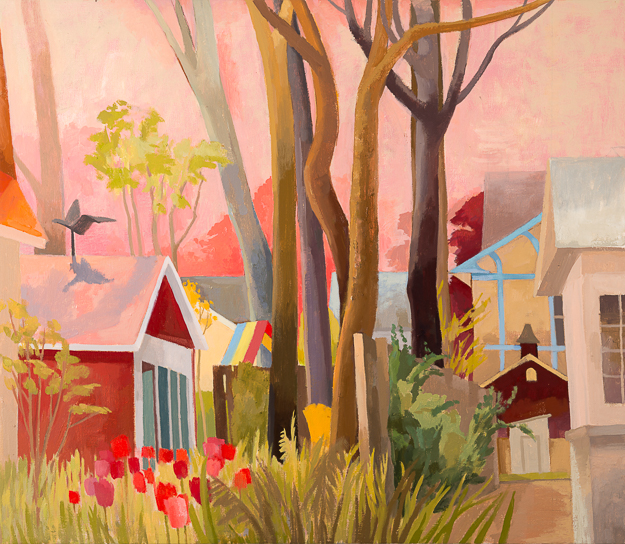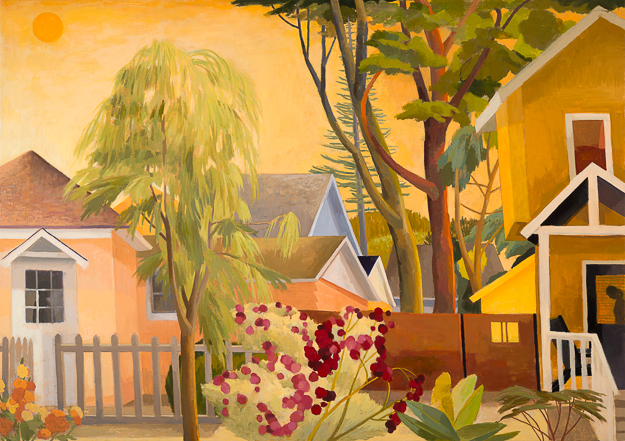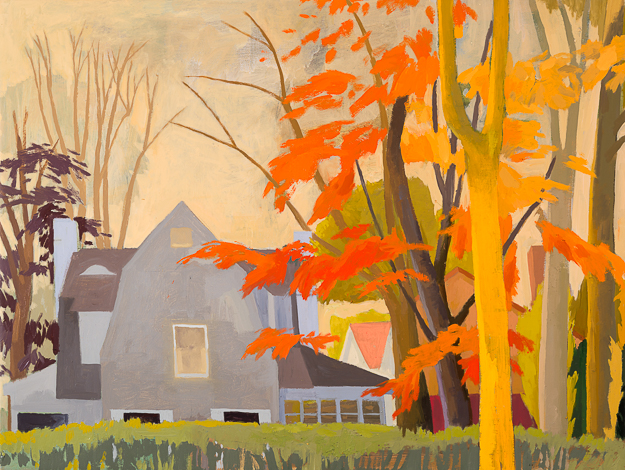
Celia Reisman transforms American suburbs into landscapes of the mind in four stages. First, she gets in her car and drives around her longtime neighborhood on the outskirts of Philadelphia – or wherever else she happens to be sojourning. Cruising the quiet streets, Reisman looks for what she calls “kernels of ideas”, scrutinizing through her windshield houses, gables, sheds, trees and turrets. When she settles on a visual detail that draws her attention, she parks her car. Then, she takes a picture of what attracted her with her phone to keep a record of the original sight.
Reisman’s current exhibition (A Moment Noticed) at the Gross McCleaf Gallery does not present these snapshots, but her artist statement provides a few examples. An iPhone picture shows a one-story house with a pitched roof and white siding, a recycling bin in the driveway, a leafless birch in the backyard. This is mundane actuality, a point of a departure for the artist.
Then, while inside her car, Reisman begins to draw. At this stage, she is both an observational artist and a fiction maker with a pencil and gouache, rendering the elements that captured her – a blue shed, a yellow fence, a closed patio umbrella capped by the snow – eliminating others, adding new ones. The drawing might change the scene from autumn to summer, banish the driveway and trashcans, reduce the latticework of branches to a handful of graceful lines. The cold autumn day now bursts forth with springtime tulips.
A motorized spectator of the suburbs, Reisman is the inverse of a strolling city flâneur, moving her vehicle up and down the street to get a better view of the house that caught her eye as if operating a mobile camera obscura. Departing from the actual, her gouache drawings are halfway places on a journey to the artist’s imagined landscapes.
Reisman’s master paintings are born in the studio. The show presents 17 of them. Each work is installed in a wooden floater frame, slightly below eye level, inviting the gallerygoer to step inside the richly hued pictorial spaces.
The moments noticed have been distilled to mystical architectural realms enjoying sunny eternity. There are no cars or cellphones. The people are rare. The real has been transfigured into a well-ordered paradise for the eye.
In “Tall Trees Day,” Reisman dissolves the environs into playful geometry: triangles of gables, trapezoids of roofs pivoting towards the onlooker to show off their fronts, ignoring rules of perspective. Nature rushes to the endless expanse of the sky. The reds are delectable. The heightened colors invigorate not just the pupil, but the palate.

When the night settles on the scene in “Tall Trees Night,” the same landscape beckons with a dark, muted orange. Everything is inviting, dreamy, transcendent.
Occasionally, Reisman frames one or two people inside a window or a door, but these are silhouettes, distant and incidental.
In “Warm World” a woman bows her head inside a door panel while her next-door neighbor stands in profile on the opposite end of the composition. Both figures are ensconced within their interiors but the scene is charged with an air of secret connection, heightened by the presence of trees, flower bushes, keyed up yellows of the facades, the dark yolk of the sun.

Only in “Echo Park Coral” do we witness contact between two people. The couple at the lower end of the composition – we only see their heads and shoulders – face each other in a moment of intimacy. A sense of silent serenity pervades the California scene, a tranquility of a world hiding itself from the din of modern life.
The same mood of enchanted remoteness prevails in all of Reisman’s works. Her suburbs do not pose existential questions, like the stories of John Cheever and Richard Yates, or interrogate the socio-political realities of American suburban sprawl. It is impossible to imagine these geometrical distillations carrying the burden of history – or market values – in the depths of their facades. Negating property lines, they abolish alienation.
Standing before the paintings, I found myself held by them, soothed by their pitched gables and chimney pots. Shadows spoke in whispers; Tudor half-timbering colluded with the trees; the fiery autumn leafs invited to recline with a book on a sunny-winking veranda. I was inhabiting the paintings like shelters. Reisman did not critique or redeem the real suburban landscape; she offered me a home inside a world that was wholly her own.

[Gross McCleaf Gallery] May 3-26, 2017;grossmccleaf.com/currentexhibition.html
